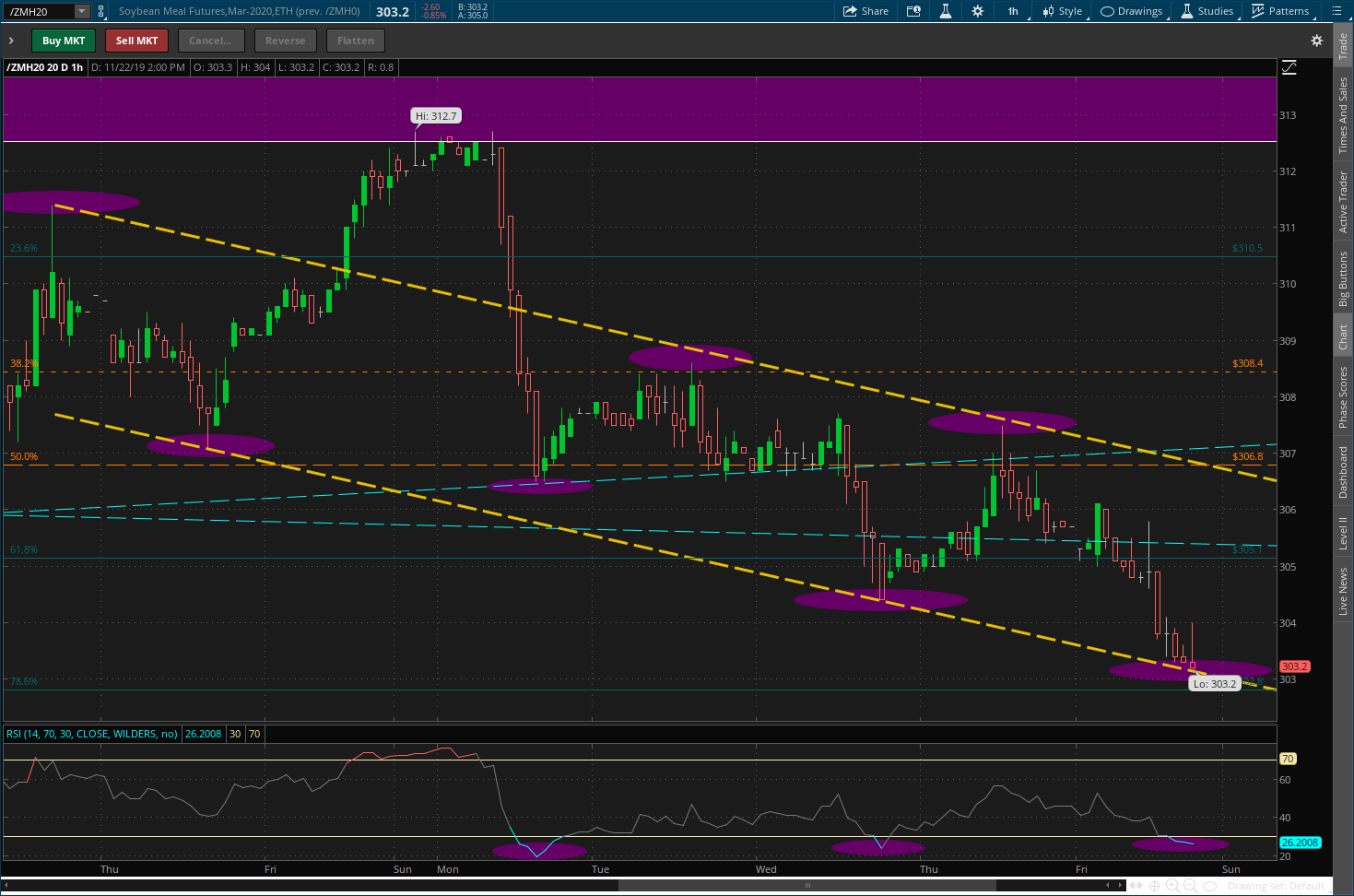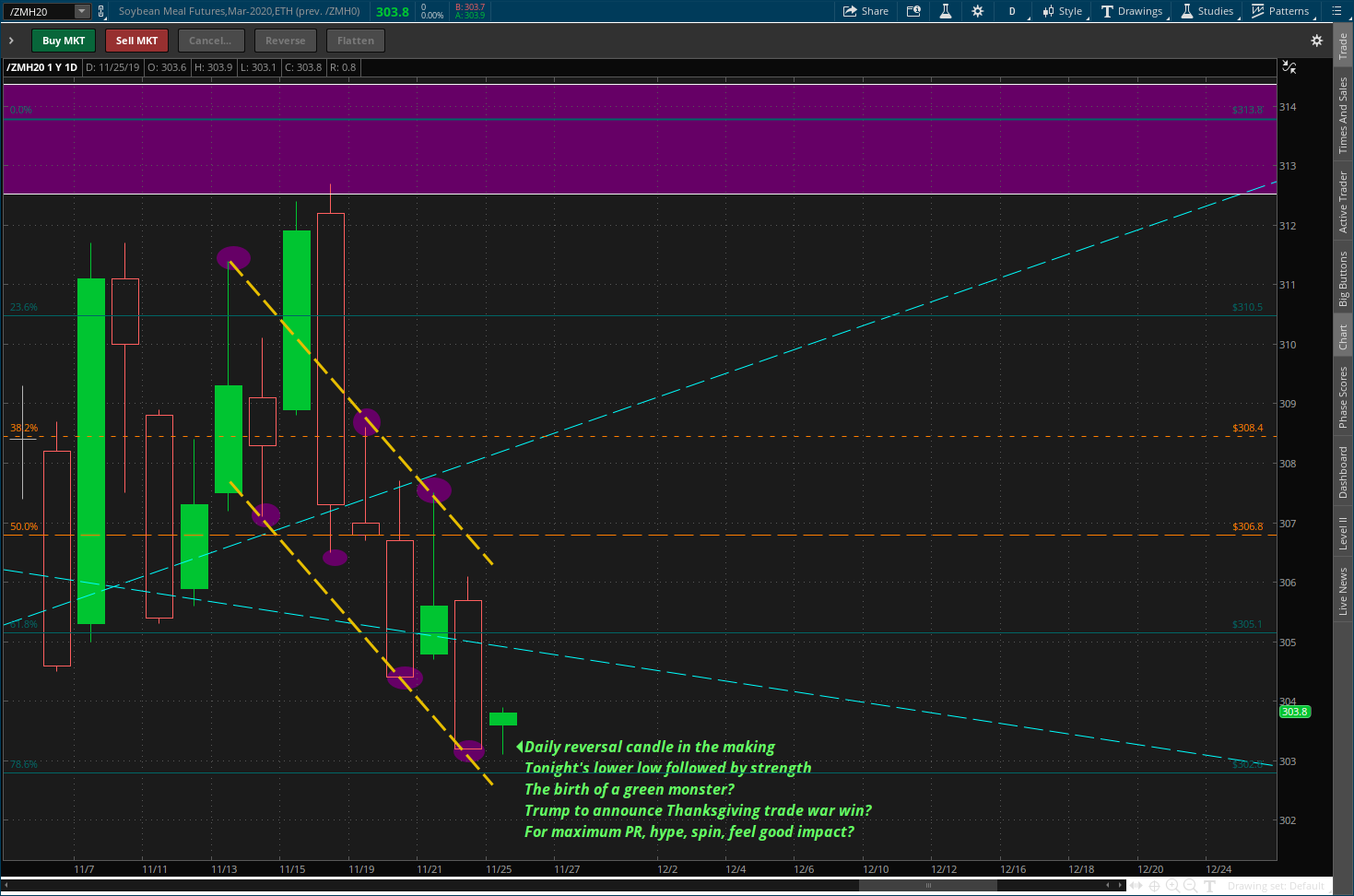

Hourly March Meal highlighting channel, cycle touchpoints and bullishly diverging relative strength index shown underneath. Plus, that there final candle from last Friday is an upside down hammer, ball peening the channel floor.
Close up on that hourly chart, vividly showing the consecutive hammer candles from the last hour of Friday's trade followed by the first hour of Sunday, tonight's action. An inverted hammer flollowed by an upright hammer whose 'handle' probed a wee bit lower and then reversed. All at the channel bottom and oscillator extreme oversold , too.
Daily candles showing double bottom and possible green reversal candle in the making. Possibly a bottom in progress.
Thanks hayman!
South America weather has been bearish.
South America weather-November
https://www.marketforum.com/forum/topic/43144/
Any unharvested beans in the Upper Midwest/Western belt will be subjected to a heavy snow........in some places later this week. This could be good for a little spike higher.
Will have to check on that. The latest USDA report on crop conditions/% harvested will be out tomorrow afternoon......

Re: Crop condition November 18, 2019
https://www.marketforum.com/forum/topic/43073/
Nov. 17: U.S. #corn was 76% harvested, up from 66% last week but slightly below trade expectations for 77%. Five-year avg is 92%. That makes #harvest19 the third slowest harvest on record since 1981. Slower on Nov. 17: 2009 58% 1992 62% Slightly faster: 1985 78% 2008 80%
#Harvest19 progress, Nov. 17, #corn (5yr avg):
Illinois 80% (97%)
Indiana 80% (91%)
Iowa 77% (93%)
Michigan 39% (75%)
Minnesota 77% (94%)
Missouri 85% (96%)
Nebraska 85% (91%)
North Dakota 23% (85%)
Ohio 75% (87%)
South Dakota 53% (91%)
Wisconsin 44% (77%)
#Soybeans were 91% harvested on Nov. 17, up from 85% last week. Trade expected 91%. Five-year avg is 95%, last year and 2009 were also just about 91% complete on Nov. 17. #harvest19
#Harvest19 progress, Nov. 17, #soybeans (5yr avg):
Illinois 92% (98%)
Indiana 91% (95%)
Iowa 95% (98%)
Michigan 76% (91%)
Minnesota 97% (99%)
Missouri 83% (89%)
Nebraska 99% (99%)
North Dakota 84% (98%)
Ohio 90% (95%)
South Dakota 95% (99%)
Wisconsin 77% (95%)
Mainly ND behind on beans but with corn, most states are behind far enough that those areas which see this heavy snow will probably lose some corn production in the field because of it.
The 3 states that will lose a bit of corn production because they are far behind and have heavy snow coming are ND, SD and MN. Possibly some northern parts of NE and central WI.
The snow map above is totals from 2 storms. A moderate one early this week, then the huge one this weekend, a bit farther north.
Meal reversal continuing to express price rise through the Sunday night session. A 2 hour candle chart showing lively price spurts up.
Daily chart showing reversal solidifying and taking on a robust appearance overnight.
WEEKLY candle chart showing developing reversal in larger context.
Corn has bounced, probably from the heavy snow coming as described above.
The forecast is still the same.
Over a foot of snow coming to the Upper Midwest/N.Plains.
Not sure how much of a bounce we can get out of this but as long as its looming, it has the potential to be supportive.
There will be some high winds associated with this storm too.........also bullish.
In fact the winds may be the most bullish!
Soybean meal is included in more than 90 percent of diets for poultry and swine
"African Swine Fever Support"
"With African Swine Fever inciting fear around the world and catastrophic damage in China and nearby regions, there is no doubt this will be a shaping event for the pig industry. ASF is transferred by contact, pig to pig and humans and feed to pigs. Its fatal potential is enough for producers to feel wary of sourcing their feed from affected areas for fear of bringing the virus straight to their pigs. The Swine Health Information Centerput out “holding time” instructions for managing feed imported from an ASF-affected area.7The time is based on a calculated half-life of viruses in soybean meal. SHIC recommended 78 days after a born-on date for sealed feed and 286 days for unsealed feed, but that recommendation only further instigated fear of ASF living in producers’ Chinese pig feed.
This virus has created a two-fold impact on the industry. First, it will continue to negatively impact the Chinese swine industry. As a result of reduced pig populations, China may reduce its imports by more than 10 MMT, pulling demand away from an already over-supplied global market.8On the other hand, swine producers in the U.S. who were previously importing cheap soybean meal from China are thinking twice. The risk of introducing a disease with a 100 percent mortality rate is a much heavier consideration than a few cents on the dollar for feedstuffs. Current market conditions make the switch away from Chinese soymeal easier than in the past and could allow the opportunity for U.S. Soy producers to prove the efficacy of their product and retain some of these consumers even after the disease is eradicated."
Soybean Meal May Boost Faster Pig Growth
“For a long time soybean meal has been thought to provide about 78% (of) the energy value as corn,” says Bob Goodband, a swine nutritionist with K-State Research and Extension. “So it hasn’t been thought of as a significant source of energy. What we found was that feeding increasing amounts of soybean meal increases the net energy value to approximately 105% and 121% of the energy provided by corn.”
risk of transmission of ASF in imported soybean products
"Most swine viruses tested in the Pacific and Atlantic transboundary models survived in soybean meal (Dee et al., 2018). In addition, porcine coronaviruses had the greatest survival in soybean meal compared to other feed ingredients (Trudeau et al., 2017). These observations suggest that if contaminated soybean products are a potential source of virus introduction. Fortunately, almost all of the U.S. pork industry uses soybean meal and related soybean products from the domestic soybean supply chain, which represents negligible risk as long as it is not cross-contaminated. In addition, about 98.9% of soybean meal produced in the U.S. is produced by solvent extraction which steps are likely to inactivate the ASF virus. These steps are conditioning (150 degrees Fahrenheit for 15 minutes), extraction (145 degrees Fahrenheit for 30 minutes), desolventizing/toasting (150 degrees Fahrenheit 10 minutes), and dryer/cooler (220 degrees Fahrenheit for 45 minutes)."
Hi hayman
That last sentence in the last post
Toasting 150 degrees F
Dryer/cooler 220 degrees F
The word cooler confuses me as 220 F is hotter
Is this a mis print
Hope I remembered the words and numbers correctly but hope you read and get my meaning
https://lipidlibrary.aocs.org/edible-oil-processing/meal-desolventizing-toasting-drying-and-cooling
"
After the solvent extraction process, the de-oiled oilseed material may be in the shape of flakes, cake particles or expanded pellet particles soaked with solvent. The de-oiled oilseed material typically contains 55 to 70 weight % dry solids, 25 to 35 weight % residual solvent, 5 to 10 weight % moisture and less than 1 weight % residual oil [1]. The de-oiled oilseed material is normally at atmospheric pressure and 55 to 60°C in temperature. In many cases the de-oiled oilseed material contains anti-nutritional factors that can inhibit digestion. As is, the de-oiled oilseed material has no commercial value, is unsafe to transport, and requires further processing.
There are two potential processing paths for the de-oiled oilseed material coming from the solvent extraction process. Over 95% of the de-oiled oilseed material is processed by the desolventizing, toasting, drying and cooling process path to produce protein-rich meal for animal feed ingredient applications. Less than 5% of the de-oiled oilseed material is processed by the flash desolventizing and cooling process path to produce protein concentrates, protein isolates and soy flour for human and specialty animal feed applications.
In the meal desolventizing, toasting, drying and cooling process path the solvent is removed from the de-oiled oilseed material and recovered for re-use, the de-oiled oilseed material is toasted to reduce anti-nutritional factors, the de-oiled oilseed material is dried to within trading limit moisture requirements, and the de-oiled oilseed material is cooled to near ambient temperature to remain flowable during storage and transport. The resultant desolventized, toasted, dried and cooled product is commonly referred to as oilseed meal."
Fascinating stuff. Thanks for educating us.
The idea of the hog disease as relates to soybean meal price seems bullish for the future. While it is accepted that hog population decline has reduced meal use, compensating poultry and aqua agriculture also consume meal. Furthermore, to protect existing hog populations, healthy clean meal must be obtained, maybe from the U.S. Instead of Chinese meal that is exposed to viral contamination. So that suspect feed meal is effectively removed from the market. And finally, the massive rebuilding of hog herds in the world will require huge clean supplies, ever increasing. With this fundamental backdrop that is already quite ripe, seems about time for beans and particularly its meal component to catch a demand wave that could carry long and strong into the foreseeable future.